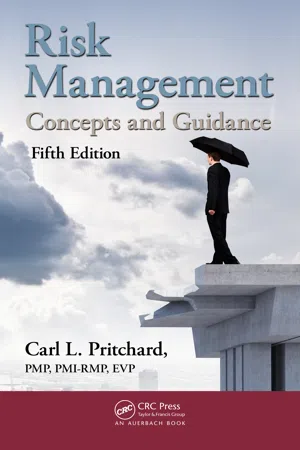
- 474 pages
- English
- ePUB (mobile friendly)
- Available on iOS & Android
About This Book
This new edition of Risk Management: Concepts and Guidance supplies a look at risk in light of current information, yet remains grounded in the history of risk practice. Taking a holistic approach, it examines risk as a blend of environmental, programmatic, and situational concerns. Supplying comprehensive coverage of risk management tools, practices, and protocols, the book presents powerful techniques that can enhance organizational risk identification, assessment, and management—all within the project and program environments. Updated to reflect the Project Management Institute's A Guide to the Project Management Body of Knowledge (PMBOK® Guide), Fifth Edition, this edition is an ideal resource for those seeking Project Management Professional and Risk Management Professional certification. Emphasizing greater clarity on risk practice, this edition maintains a focus on the ability to apply "planned clairvoyance" to peer into the future. The book begins by analyzing the various systems that can be used to apply risk management. It provides a fundamental introduction to the basics associated with particular techniques, clarifying the essential concepts of risk and how they apply in projects. The second part of the book presents the specific techniques necessary to successfully implement the systems described in Part I. The text addresses project risk management from the project manager's perspective. It adopts PMI's perspective that risk is both a threat and an opportunity, and it acknowledges that any effective risk management practice must look at the potential positive events that may befall a project, as well as the negatives.Providing coverage of the concepts that many project management texts ignore, such as the risk response matrix and risk models, the book includes appendices filled with additional reference materials and supporting details that simplifying some of the most complex aspects of risk management.
Frequently asked questions
Information
PART I
Risk Processes and Practices
Why Risk Management?
1
Risk Management Practices
A Systematic Process
- Plan risk management. In this area, we establish project risk infrastructure and a project-specific risk management plan. This includes creating risk language, tolerances, and thresholds.
- Identify risks. We describe events that will have potentially negative or positive impacts on projects, with descriptions that include the event that may happen and its specific impact.
- Qualify risks. We evaluate risk according to nonnumeric assessment protocols.
- Quantify risks. We evaluate the most significant risks and/or the project as a whole according to their numeric probability and impact.
- Plan risk responses. We determine, evaluate, and communicate strategies to deal with or preclude risks.
- Monitor and control risks. We put risk management and response plans into action.
Summary
- Risk management is essential for every project.
- Risk management should be a systematic process.
- All projects should have some documented risk management activity.
2
Risk Concepts
Table of contents
- Cover
- Half Title
- Title Page
- Copyright Page
- Table of Contents
- List of Figures
- List of Tables
- Preface
- Author
- Introduction
- Part I Risk Processes and Practices: Why Risk Management?
- Part II Risk Management Techniques
- Glossary
- Appendix A: Contractor Risk Management
- Appendix B: An Abbreviated List of Risk Sources
- Appendix C: Basic Probability Concepts
- Appendix D: Quantifying Expert Judgment
- Appendix E: Special Notes on Software Risk
- Index